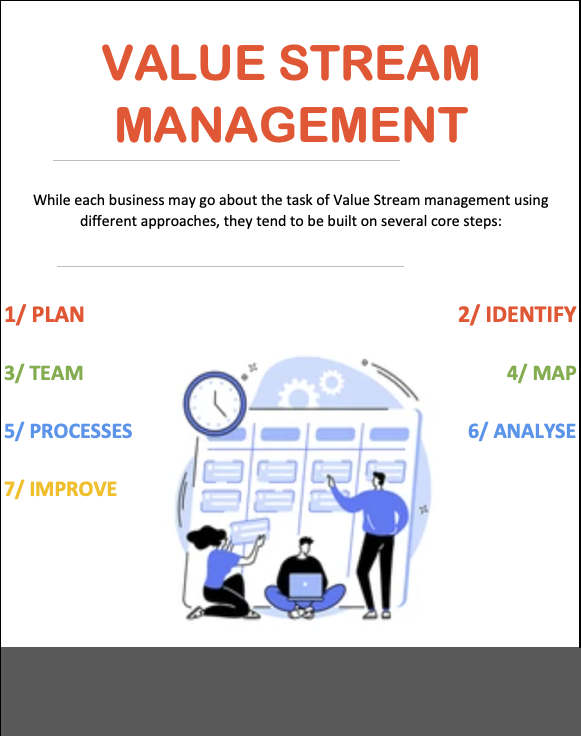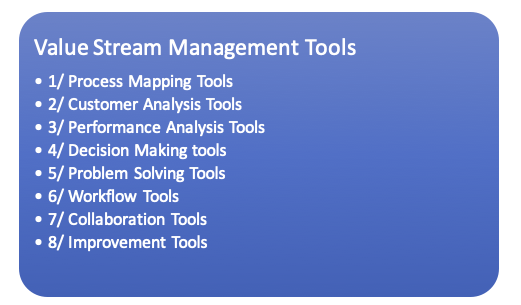
Value stream management is a methodology that uses various techniques and tools to map, assess and improve interconnected processes and systems.
Results of this approach help increase the efficiency and effectiveness of processes and drive higher value to the customer.
Value Stream Management can be applied during various product lifecycle stages, including development, production and delivery.
In this article, we’ll look in depth at Value stream management, what it is, who uses it, why it’s used, associated benefits and potential issues.
We’ll be covering:
- What is Value Stream management
- Why Value Stream Management
- Value Stream Management Examples
- Types of Value Streams
- Value Stream Management process
- Value Stream Management Tools
- Benefits of Value Stream Management
- Issues associated with Value Stream Management
What is Value Stream Management?
In delivering products (whether that’s to internal or external customers) businesses are likely to execute a series of complex and interconnected processes.
Each process step contributes value to the deliverable until it meets the process concludes.
Value stream management aims to provide insight into those steps, enabling businesses to maximize the value contributed and utilize efficient and effective processes, delivering against customer needs and requirements.
When effective, value stream management helps drive higher levels of value/contribution (and enables us to assess the product from the customer’s perspective) than through using more traditional management methods such as via a disconnected, silo-based approach.
Value stream management does this in part through a view of the whole system, particularly around performance of and interfaces between processes.
Value Stream Management can be used during all stages of the product development lifecycle, from the initial idea to building and testing and eventually delivery to the customer.
Armed with the resultant information, businesses can target improvements, whether that’s through reducing waste, improving efficiency, or driving quality.
Why Value Stream Management
In today’s competitive environment, businesses want reliable, repeatable, efficient ways of delivering value to their customers.
Most businesses are challenged with complex issues; these can include
- Lacking a single coherent view of performance driven by accurate data
- Processes that fail to add value or control quality
- Lack of collaboration between teams
- Lack of knowledge and control of key processes
- Lack of integration across process steps
- Failing to deliver what the customer needs
Value Stream Management looks to address these by introducing processes and methods that help control key events within a business.
Through this, we can look to ensure processes are calibrated to deliver against your organizational goals in the most efficient and effective ways.
Value streams have certain characteristics, these include
- Are driven by a customer requirement (customers can be internal or external)
- Have a series of interconnected steps or processes
- Each step or process contributes value to the product.
- Steps are likely to consist of cross-functional activities.
- Each step has costs, dependencies and lead time associated with it.
- The efficiency and effectiveness of steps do not have to be (and are unlikely to be) uniform throughout the value stream.
Value Stream Management Examples
Let’s take a look at some simple examples of value stream management.
Below are two example value streams.
Both of these simple examples show the key steps of their overall process and how the value increases as the stream progresses.
Note that each “block” shown is likely to have certain characteristics
- May contain varied processes
- Has a goal or purpose
- Can have its performance assessed
- Will have interfaces into the next block
- Contributes value to the overall product or service
- Will have dependencies
- Value Stream Management focuses on maximizing value as it flows through the process from the initial customer order to delivery of the product or service to the customer.
Example 1 Automobile assembly

Example 2 Software development

Types of Value Streams
There are several types of Value Streams, these include
- Operational value streams – these can be described as the process steps or activities that a business executes to deliver a product or service to a customer. An example could be manufacturing a vehicle.
- Development value streams – these are described as the steps which convert a premise into a product (which could then be manufactured/delivered through operational value streams). An example could be the design of an aircraft component or software development.
Whatever type of value stream you’re deploying, in order to deliver the most effective set of processes, there is a key need: knowing your customer and their needs.
Supporting processes can then be built and deployed in order to meet them.
Value Stream Management Process

While each business may go about the task of Value Stream management using different approaches, they tend to be built on several core steps, which we describe below:
1. Planning
Steps include:
- Establishing quantifiable goals; these could be short and/or long-term.
- Establish what information is needed to drive the management process.
- Establish a timescale to achieve goals
- Establish resources needed to deliver goals
2. Identifying value streams.
Next, you must decide which value streams you plan to investigate. Companies are likely to be highly complex with numerous value streams, each with its unique challenges, so it’s simply a case of deciding areas of importance that help contribute to the goals set in step 1.
3 Choosing the team.
- This step involves choosing the base team with the correct skillsets to deliver value stream management. These teams are likely to be multi-disciplined and have experience in change and improvement.
- Teams are not rigid and may flex over time. They are likely to include team members actively involved in the value stream. For example, in an automobile assembly, value stream management will include operators, engineers, supply chain, logistics, etc.
4. Mapping the value stream.
Once you’ve chosen your value stream, map out the process from start to finish. Businesses must focus on each step from a level that makes sense to the management process and adequately describes/defines interfaces, dependencies, requirements etc.
5. Identify processes.
You then need to identify how processes are executed. Are processes documented? Do policies exist?
Understanding this detail means it’s easier to understand roles and improve communication in the next stage.
6. Tracking and analysis. In order to drive improvement, businesses implementing value stream management will need to identify performance criteria and associated data that the management processes will use.
Obtaining reliable data can be challenging; however, teams should focus on quality and look to implement improvement plans where data is unavailable.
7. Improve. Finally, use your data to identify required changes and implement necessary improvements. This can be a long-term step, as you’ll need further data after implementing any changes.
Value Stream Management Tools

VSM will utilize a range of tools and methods in order to achieve its goals
Common tools include
- Process Mapping tools
- Customer analysis tools
- Performance Analysis tools
- Decision-making tools
- Workflow Management tools
- Collaboration tools
- Problem-solving tools
- Improvement tools
There is a myriad of tools that can be utilized by businesses in the management of their value streams, from bespoke software tools to tools used in methodologies such as lean.
Selecting appropriate tools can seem a daunting task. When selecting tools, consider your goals and how the tool will help achieve the desired end state. Also, bear in mind up-front activities like training which may be required.
Benefits of Value Stream Management
There are numerous benefits associated with value stream management; these include:
1/ Improved awareness of process flows – through process mapping, activities required to deliver value to the customer are identified, allowing closer scrutiny and control.
2/ Identification and improvement of bottlenecks – Bottlenecks are common when teams don’t communicate, or the same issues keep happening. By gathering holistic data on each stage of the development cycle, you can see when bottlenecks happen and why.
3/ Opportunity to deploy continuous improvement – as processes and issues are highlighted, continuous improvement activities can be deployed to improve performance
4/ Improved Decision-Making – Unsurprisingly, evaluating the value streams can enable improved, informed, strategic decision-making.
5/ Improved Governance – Finally, value stream management improves governance by holding departments accountable and giving leaders and decision-makers usable information for implementing change.
6/ Customer satisfaction – ultimately, value stream management should provide a positive impact on the customer through improved processes, closer awareness of customer requirements and focus on quality and schedule.
Issues with Value Stream Management
Value stream management in not a panacea and does come with some common challenges; these include:
- Value stream management is most effective when it supports known goals. Where goals are fuzzy, the mileage may vary.
- Value stream management is a methodology, and just because you do it, it doesn’t automatically provide clarity and performance. Part of the challenge can be figuring out what to do with the results and how best to utilize the methods and tools to improve performance.
- The wealth of data you can capture during the process can be overwhelming. For some businesses, it can be difficult to decide which areas are most in need of improvement.
- Value stream management is not free; it requires resources and investment in order to deliver against goals.
- It is not a one-off event and requires sustainment that drives cost.
- It can create change/transformation, which may necessitate business disruption, which may bring with it a challenge which business may be ill-prepared for
Summary
Value stream management is a commonly used business methodology that drives and sustains performance.
It derives benefits through assessing processes and interfaces between processes and driving performance.
It can be challenging to implement depending on circumstances but can provide a range of notable benefits, visibility, improved decision making, and workflow management.
Perhaps the key benefit is that, through analysis, each value stream becomes understood, issues become clear, and improvements quantifiable. This enables an organization to visualize how value flows throughout its processes concluding with its customer.
Have you taken part in value stream management? What are your thoughts? We’d love to hear from you; you can reach out via Twitter or the comments below.
